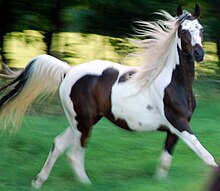A horse breed is a selectively bred population of domesticated horses, often with pedigrees recorded in a breed registry. However, the term is sometimes used in a broader sense to define landrace animals of a common phenotype located within a limited geographic region, or even feral "breeds" that are naturally selected. Depending on definition, hundreds of "breeds" exist today, developed for many different uses. Horse breeds are loosely divided into three categories based on general temperament: spirited "hot bloods" with speed and endurance; "cold bloods," such as draft horses and some ponies, suitable for slow, heavy work; and "warmbloods," developed from crosses between hot bloods and cold bloods, often focusing on creating breeds for specific riding purposes, particularly in Europe.

The Arabian or Arab horse is a breed of horse that originated on the Arabian Peninsula. With a distinctive head shape and high tail carriage, the Arabian is one of the most easily recognizable horse breeds in the world. It is also one of the oldest breeds, with archaeological evidence of horses in the West Asia that resemble modern Arabians dating back 4,500 years. Throughout history, Arabian horses have spread around the world by both war and trade, used to improve other breeds by adding speed, refinement, endurance, and strong bone. Today, Arabian bloodlines are found in almost every modern breed of riding horse.
Purebreds are "cultivated varieties" of an animal species achieved through the process of selective breeding. When the lineage of a purebred animal is recorded, that animal is said to be "pedigreed". Purebreds breed true-to-type which means the progeny of like-to-like purebred parents will carry the same phenotype, or observable characteristics of the parents. A group of purebreds is called a pure-breeding line or strain.
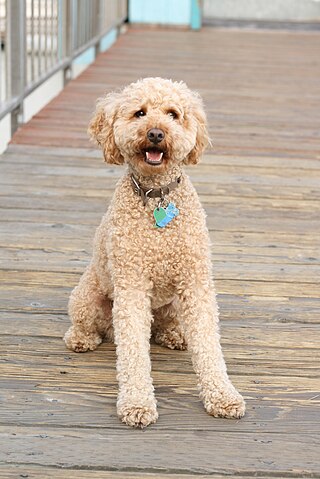
A crossbreed is an organism with purebred parents of two different breeds, varieties, or populations. Crossbreeding, sometimes called "designer crossbreeding", is the process of breeding such an organism. While crossbreeding is used to maintain health and viability of organisms, irresponsible crossbreeding can also produce organisms of inferior quality or dilute a purebred gene pool to the point of extinction of a given breed of organism.
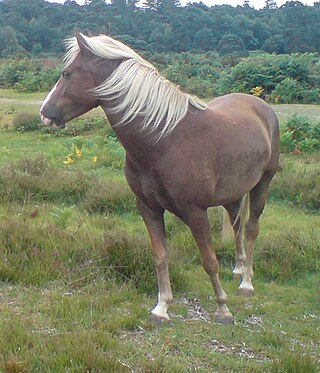
The New Forest pony is one of the recognised mountain and moorland or native pony breeds of the British Isles. Height varies from around 12 to 14.2 hands ; ponies of all heights should be strong, workmanlike, and of a good riding type. They are valued for hardiness, strength, and sure-footedness.

The Gypsy Cob, also known as the Traditional Gypsy Cob, Irish Cob, Romani Cob, Gypsy Horse, or Gypsy Vanner, is a type or breed of domestic horse from the islands Great Britain and Ireland. It is a small, solidly-built horse of cob conformation and is often, but not always, piebald or skewbald; it is particularly associated with Irish Travellers and English Romanichal Travellers of Ireland and Great Britain. There was no stud-book or breed registry for horses of this type until 1996, but as breeders developed standards and recorded pedigrees, there are now organizations that register qualifying horses..
A breed registry, also known as a herdbook, studbook or register, in animal husbandry and the hobby of animal fancy, is an official list of animals within a specific breed whose parents are known. Animals are usually registered by their breeders while they are young. The terms studbook and register are also used to refer to lists of male animals "standing at stud", that is, those animals actively breeding, as opposed to every known specimen of that breed. Such registries usually issue certificates for each recorded animal, called a pedigree, pedigreed animal documentation, or most commonly, an animal's "papers". Registration papers may consist of a simple certificate or a listing of ancestors in the animal's background, sometimes with a chart showing the lineage.

The Dales Pony is a British breed of pony or small horse. It originated in, and is named for, the Dales of Yorkshire in northern England. It is one the nine native mountain and moorland pony breeds of the United Kingdom, and belongs to the broader Celtic group of ponies which extends from Portugal and northern Spain to Scandinavia.

The Quarab is a horse breed from the United States, developed from a part-Arabian cross of Arabian horses, American Quarter Horses and Paint horses. Members of the breed are found that resemble all three of the foundation breeds, leading to three recognized types: Straight or Foundation, Stock and Pleasure. Although there have been records of crosses between the three breeds throughout the history of their respective registries, the first Quarab registry was formed in 1984, but later went out of business. In 1999, the International Quarab Horse Association was formed and remains the leading force in Quarab breeding. In order to be registered with the IQHA, horses must have at least 1/8 blood from both the Arabian and stock horse types.

The Azteca is a horse breed from Mexico, with a subtype, called the "American Azteca", found in the United States. They are well-muscled horses that may be of any solid color, and the American Azteca may also have Paint coloration. Aztecas are known to compete in many western riding and some English riding disciplines. The Mexican registry for the original Azteca and the United States registries for the American Azteca have registration rules that vary in several key aspects, including ancestral bloodlines and requirements for physical inspections. The Azteca was first developed in Mexico in 1972, from a blend of Andalusian, American Quarter Horse and Mexican Criollo bloodlines. From there, they spread to the United States, where American Paint Horse blood was added.
The Welara is a part-Arabian pony breed developed from the Arabian horse and the Welsh pony. It was originally bred in England by Lady Wentworth at the Crabbet Arabian Stud in the early 1900s from imported Arabian stallions and Welsh pony mares. Breeding then spread throughout North America. In 1981, a breed registry was formed in the United States, and a studbook began to be published. They are used for many disciplines of English riding, and are known for their refinement, hardiness and spirit.
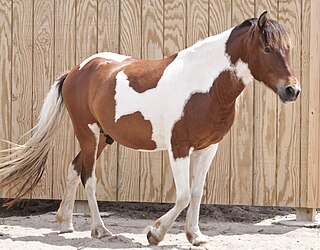
A pinto horse has a coat color that consists of large patches of white and any other color. The distinction between "pinto" and "solid" can be tenuous, as so-called "solid" horses frequently have areas of white hair. Various cultures throughout history appear to have selectively bred for pinto patterns.
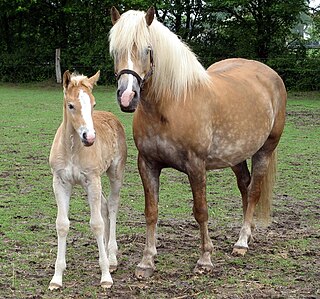
The Haflinger, also known as the Avelignese, is a breed of horse developed in Austria and northern Italy during the late 19th century. Haflinger horses are relatively small, are always chestnut with flaxen mane and tail, have distinctive gaits described as energetic but smooth, and are well-muscled yet elegant. The breed traces its ancestry to the Middle Ages; several theories for its origin exist. Haflingers, developed for use in mountainous terrain, are known for their hardiness. Their current conformation and appearance are the result of infusions of bloodlines from Arabian and various European breeds into the original native Tyrolean ponies. The foundation sire, 249 Folie, was born in 1874; by 1904, the first breeders' cooperative was formed. All Haflingers can trace their lineage back to Folie through one of seven bloodlines. World Wars I and II, as well as the Great Depression, had a detrimental effect on the breed, and lower-quality animals were used at times to save the breed from extinction. During World War II, breeders focused on horses that were shorter and more draft-like, favored by the military for use as packhorses. The emphasis after the war shifted toward animals of increased refinement and height.

Sabino describes a distinct pattern of white spotting in horses. In general, Sabino patterning is visually recognized by roaning or irregular edges of white markings, belly spots, white extending past the eyes or onto the chin, white above the knees or hocks, and "splash" or "lacy" marks anywhere on the body. Some sabinos have patches of roan patterning on part of the body, especially the barrel and flanks. Some sabinos may have a dark leg or two, but many have four white legs. Sabino patterns may range from slightly bold face or leg white markings—as little as white on the chin or lower lip—to horses that are fully white.
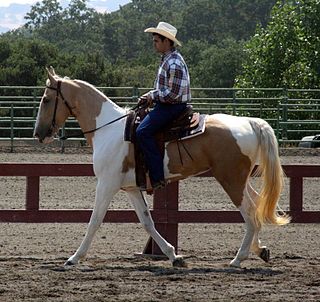
The Spotted Saddle Horse is a horse breed from the United States that was developed by crossing Spanish-American type gaited pinto ponies with gaited horse breeds, such as the Tennessee Walking Horse. The result was a colorful, smooth-gaited horse, used in the show ring and for pleasure and trail riding. Two registries have been created for the breed, one in 1979 and the other in 1985. The two have similar registration requirements, although one has an open stud book and the other is slightly more strict with regard to parentage requirements, having a semi-closed stud book. The Spotted Saddle Horse is a light riding horse, always pinto in color. Solid-colored foals from registered parents may be registered for identification purposes, so their pinto-colored foals have documented parentage. They always perform an ambling gait, rather than a trot, in addition to the gaits of walk and canter, performed by all breeds.
A cropout, crop-out or crop out is a horse with body spots, including pinto or leopard complex spotting, or "high white" horse markings, with a sire and dam who both appeared to have been solid-colored. There are several variations in the definition, depending on the breed registry involved. There are multiple genetic reasons that may cause a horse to be a cropout. Sometimes solid-colored horses throw cropouts because some spotting patterns are recessive genes that are not necessarily expressed unless the relevant allele is inherited from both parents. Other times a gene may be a dominant or incomplete dominant but so minimally expressed that the horse looks solid but can pass flashy color on to its offspring.
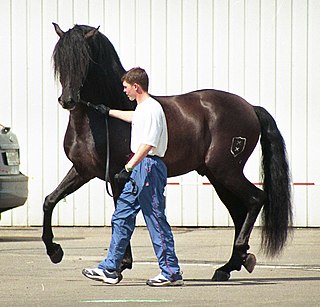
The Andalusian, also known as the Pure Spanish Horse or PRE, is a horse breed from the Iberian Peninsula, where its ancestors have lived for thousands of years. The Andalusian has been recognized as a distinct breed since the 15th century, and its conformation has changed very little over the centuries. Throughout its history, it has been known for its prowess as a war horse, and was prized by the nobility. The breed was used as a tool of diplomacy by the Spanish government, and kings across Europe rode and owned Spanish horses. During the 19th century, warfare, disease and crossbreeding reduced herd numbers dramatically, and despite some recovery in the late 19th century, the trend continued into the early 20th century. Exports of Andalusians from Spain were restricted until the 1960s, but the breed has since spread throughout the world, despite their low population. In 2010, there were more than 185,000 registered Andalusians worldwide.
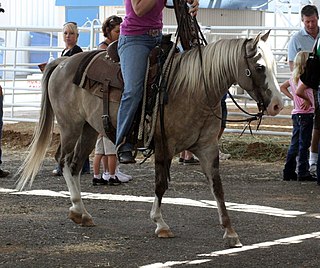
The Quarter Pony is a breed of pony that is similar to the American Quarter Horse. It stands up to 14.2 hands high and was developed from American Quarter Horse foundation bloodstock. The breed was originally developed from Quarter Horses that did not meet the American Quarter Horse Association's height requirement. It is bred to look like a small Quarter Horse, although the various registries also allow crosses with other breeds, including Paint horse, Appaloosa and Pony of the Americas, all stock types. It is one of the most versatile horse breeds there are. There are three registries for the Quarter Pony, all with slightly different registration requirements. The first registry was begun in 1964, and two more were started in the 1970s. The breed is used today in a variety of Western and English riding disciplines.

A part-Arabian, partbred Arabian or, less precisely, half-Arabian, is a horse with documented amounts of Arabian horse breeding but not a purebred. Because the Arabian is deemed to be a breed of purebred horse dating back many centuries, the modern breed registries recognized by the World Arabian Horse Organization generally have tightly closed stud books which exclude a horse from registration if it is found to contain any outside blood. However, Arabian breeding has also been used for centuries to add useful traits to countless other horse breeds. In the modern era, crossbreeding has been popular to combine the best traits of two different breeds, such as color, size, or ability to specialize in a particular equestrian discipline.

The Mountain Pleasure Horse is a breed of gaited horse that was developed in the Appalachian Mountains of Eastern Kentucky. This breed reflects the primitive Appalachian gaited horse type and genetic testing shows them to share ancestry with earlier breeds developed in the region, including the American Saddlebred, the Tennessee Walking Horse and the Rocky Mountain Horse. Some Mountain Pleasure Horse bloodlines are traceable for over 180 years.
